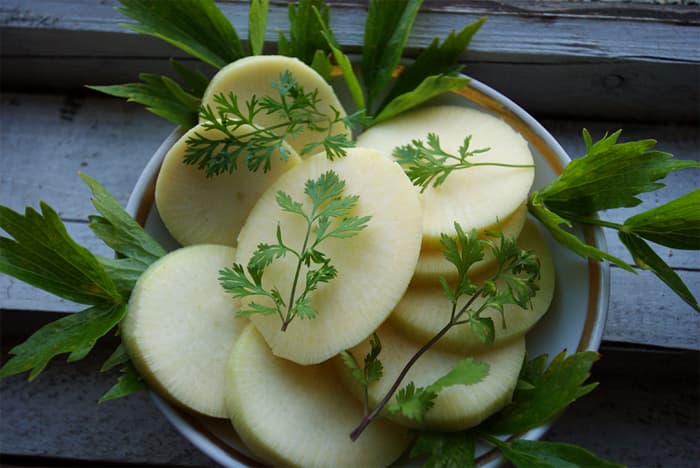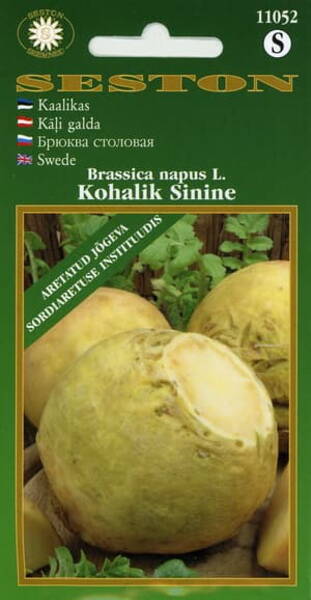A popular variety of table rutabaga in Estonia, bred at the breeding and seed station in Jõgeva, which grows well in northern European conditions.
The variety is early ripening, flat-rounded, with tasty yellow flesh. The average weight of the root crop is 500-900 g. The color of the root crop is yellow, turning to purple in its upper part.
Excellent storage.
1,0 g = 300-350 seeds.

* Rutabaga is a cold-resistant plant. Seeds begin to germinate at +3..+5°C, and the optimum temperature is +16..+18°C. Leaves and roots form quickly in moderately warm weather.
Rutabaga is demanding high soil moisture, it does not tolerate both prolonged waterlogging and a strong lack of moisture.
Ridges with any relief are suitable for swede, even with a northern slope, but better with a flat surface. Carrots, beets, and potatoes are considered the best predecessors; plots from under cabbage, turnips, radishes, and radishes are of little use.
Rutabaga is grown by sowing seeds and seedlings, which provides accelerated production for 25-30 days. For seedlings, seeds are sown sparsely under film shelters from the second half of April. The soil for rutabaga is prepared in the same way as for other vegetable crops. Organic fertilizers are best applied under the predecessor, mineral fertilizers give an average of 150-180 g per 1 sq. m of potash and 90-120 g of nitrogen and phosphorus.
Seeds are sown or seedlings are planted in rows with a row spacing of 40-45 cm and between plants 18-20 cm.
Plant care consists of regular watering, and loosening, especially during the emergence of seedlings, to prevent the formation of a soil crust. In the phase of 2-3 true leaves, with a seedless method, the plants are thinned out, leaving the best of them at a distance of 7-8 cm at first, and then finally - up to 18-20 cm. And, of course, weeding, protection from cruciferous fleas and other pests.
For early consumption, swede is harvested 2-3 times selectively after the formation of root crops 8-10 cm in size.
The late harvest is harvested before the onset of cool weather - in September and October, but always before the onset of frost, in dry weather. After cooling, the root crops are placed in cellars or cellars and stored in the same way as beets. The optimum storage temperature in winter is +1..+2°С.
Harvesting and storage.
For summer use, plants are harvested selectively, as roots form, reaching a diameter of 5-7 cm, which occurs approximately 40-50 days after transplanting. In this phase, they already have good taste, are quite nutritious, and contain more vitamin C.
Root crops intended for use in autumn and winter are harvested at one time, at the end of the growing season, in such a way as to prevent them from freezing. Harvesting should be done in sunny, dry weather.
The table turnip is easily pulled out of the soil. In healthy plants, the leaves are immediately cut short (to a height of about 1 cm). Through them, significant evaporation of moisture occurs, and uncircumcised root crops quickly lose weight and juiciness. At the same time, the axial root is cut at a distance of about 1 cm from the bottom of the root crop. At the same time, root crops are sorted into economically viable and defective. Plants with a thick overgrown head and a large number of thick lateral roots are classified as non-marketable, as they have coarser flesh and worse taste than standard ones.
During harvesting, cleaning root crops from the ground, and storing them for storage, turnips should be handled carefully: do not hit them against each other and against hard objects to shake off the ground, do not throw, do not damage - all this will adversely affect the safety of root crops in winter.
Root crops are stored in individual gardens in basements, and caissons at a temperature of 0 +1 °C (it is allowed to lower the temperature to -0.5-1 °C) and humidity in the range of 90-95%. It is possible to keep swede well in pits with a narrowed bottom, which can be dug on the site, provided that the ground is high and there is no flood water. Rutabaga is loaded into them when the earth in the upper layer cools down to +5 +7 °С.
The use of swede in medicine.
For medicinal purposes, swede is consumed both raw and after steaming in the oven or on a Russian stove. Rutabaga is advisable to use to enhance intestinal motility with constipation. In this case, it is recommended to consume 100-150 g of finely chopped raw swede or 250 g of boiled mashed potatoes 2-3 times a week. For therapeutic purposes, they drink a third glass of juice three times a day, preparing it each time before drinking. It is especially effective as an expectorant and diuretic. Juice is used to treat burns and pustular skin diseases. Since rutabaga juice has a specific taste, to improve its taste, it is advisable to add a little juice from currants, raspberries, and cranberries to it.
In folk medicine, swede in the form of gruel is used for poorly healing wounds and ulcers. Seeds ground in water can be given to children with measles, they are gargled with a throat and mouth for disinfection. It should be borne in mind that swede should be used with caution in inflammatory diseases of the stomach and intestines, as well as in renal inflammation. With frequent and abundant use of swede, gas formation in the intestine increases.
Eng.: Swedish turnip, Swede. Bot.: Brassica napus L. var. napobrassica.
* The use of root vegetables in cooking.
The sweet, juicy flesh of the turnip can be eaten raw: grated turnip together with carrots, apples, etc. seasoned with vegetable oil, sour cream or mayonnaise. In addition, it is cooked in baked, stewed, and fried form, both on its own and as a side dish for meat and fish dishes. It is also used to prepare prefabricated vegetables, vegetarian and meat soups, as well as carrots and white roots. Rutabaga can be used to cook the same dishes as turnips.
Spicy salad. Medium-sized swede, egg - 2 pcs., onion, salt, mayonnaise 200 g, greens. Peel the rutabaga from the skin and grate on a coarse grater. Add chopped eggs and onion, cut into thin strips, salt very little, add mayonnaise, mix, transfer to a salad bowl, and garnish with herbs.
Soup puree of swede with potatoes and cabbage. 500 g of swede, 400 g of potatoes, 300 g of cabbage, 5 tablespoons of green peas, sour cream, and salt to taste. Boil turnips, potatoes and cabbage, rub through a sieve and dilute with vegetable broth to the desired density. Before serving, add grated green peas and season with sour cream.
Milk soup with swede and zucchini. 200 g of swede, 0.5 l of milk, 1 small leek, 100 g of zucchini, 1 tablespoon of butter, and salt. Chopped turnip roots and leek and fry in oil. Put in boiling milk, add zucchini and cook until tender.
A decoction of vegetables, legumes and mushrooms. 1 kg fresh cabbage, 2 potatoes, 3 onions, 1 parsley root, 1 celery root, 1 leek, 1 carrot, 1 swede, 1 cup peas, 0.5 cup beans, 2-3 dried mushrooms, 20 g vegetable oil, 2 litres of water. Finely chop the onion, put it in a saucepan, add oil and simmer until golden brown. Pour in water, put whole roots of parsley, celery, carrots, turnips, leeks, cabbage, mushrooms, potatoes, pre-soaked peas and beans and cook over low heat until the vegetables are ready. If the water boils away, you can add boiling water. Strain the broth, and use the vegetables for a side dish.
Rutabagas with potatoes. 400 g swede, 5 medium potatoes. Washed and peeled swede cut into cubes, pour a small amount of boiling water and cook until half cooked. Add diced potatoes, salt, cook until fully cooked, mash with a crush. Serve the dish garnished with herbs. Can also be used as a garnish.












